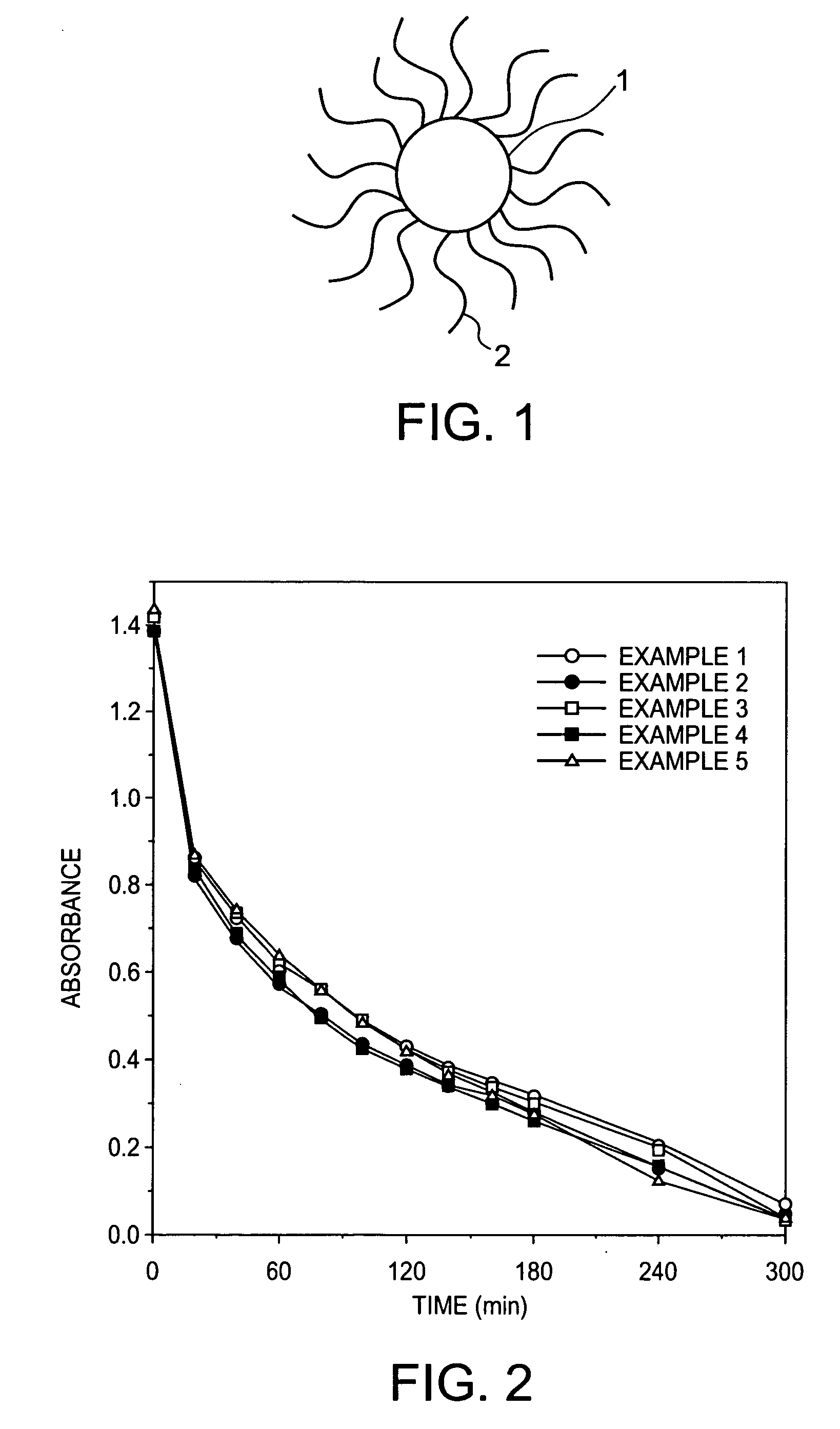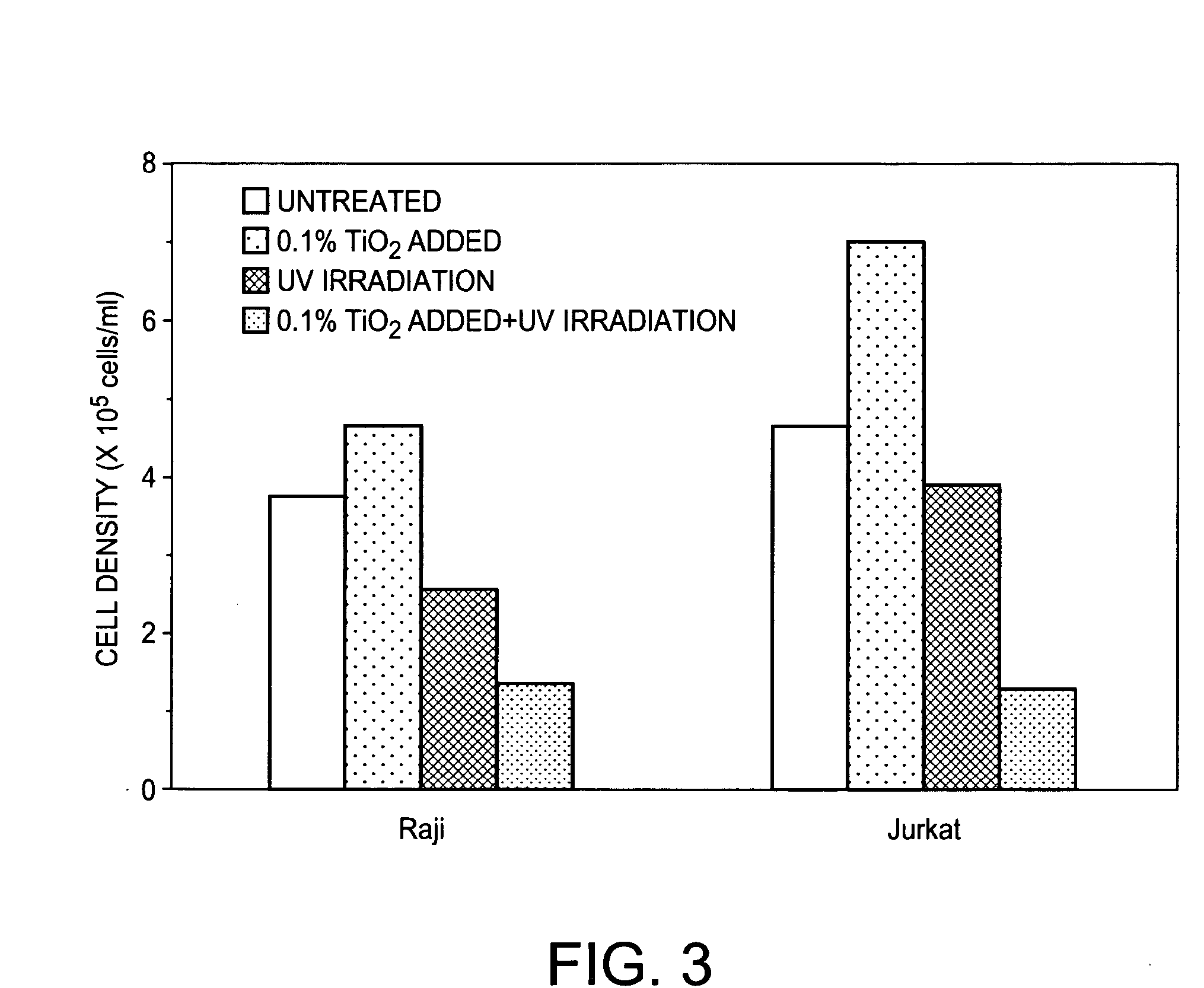Surface-modified titanium dioxide fine particles and dispersion comprising the same, and method for producing the same
a technology of titanium dioxide and fine particles, which is applied in the field of surface-modified titanium dioxide fine particles and dispersion comprising the same, and the method of producing the same, can solve the problems of nitric acid-containing acidic titanium dioxide sol, agglomeration or precipitation, and not homogeneous dispersion, so as to improve dispersibility and stability, improve dispersibility in aqueous solvents, and improve the effect of dispersibility
- Summary
- Abstract
- Description
- Claims
- Application Information
AI Technical Summary
Benefits of technology
Problems solved by technology
Method used
Image
Examples
example 1
[0027] Introduction of Polyacrylic Acid into Titanium Dioxide Particles (1)
[0028] Titanium tetraisopropoxide (3.6 g) and 3.6 g of isopropanol were mixed together, and the mixture was added dropwise to 60 ml of ultrapure water under ice cooling for hydrolysis. After the completion of the dropwise addition, the reaction solution was stirred at room temperature for 30 min. After the stirring, 1 ml of 12 N nitric acid was added dropwise thereto, and the mixture was stirred at 80° C. for 8 hr for peptization. After the completion of the peptization, the reaction solution was filtered through a 0.45-μm filter, followed by solution exchange through a desalination column (PD10; Amersham Biosciences K.K.) to prepare a titanium dioxide sol having a solid content of 1%. This dispersion liquid was placed in a 100 ml-volume vial bottle and was ultrasonicated at 200 kHz for 30 min. The average diameter of the dispersed particles before the ultrasonication and the average diameter of the disperse...
example 2
[0029] Introduction of Polyacrylic Acid into Titanium Dioxide Particles (2)
[0030] In quite the same manner as in Example 1, polyacrylic acid-bonded titanium dioxide fine particles were synthesized and were used to prepare an aqueous polyacrylic acid-bonded titanium dioxide solution having a solid content of 1.5%, except that STS-01 (Ishihara Sangyo Kaisha Ltd., solid content: 20%) as a nitric acid-containing acidic anatase sol was used as the titanium dioxide sol. The diameter of the dispersed polyacrylic acid-bonded titanium dioxide fine particles thus obtained was measured and was found to be 66.6 nm. The aqueous polyacrylic acid-bonded titanium dioxide solution was desalinated through a desalination column PD10 and was then dried at 100° C. to prepare polyacrylic acid-bonded titanium dioxide fine particles (anatase form).
example 3
[0031] Introduction of Polyacrylic Acid into Titanium Dioxide Particles (Part 3)
[0032] In quite the same manner as in Example 2, polyacrylic acid-bonded titanium dioxide fine particles were synthesized and were used to prepare an aqueous polyacrylic acid-bonded titanium dioxide solution having a solid content of 1.5%, except that the synthesis temperature was 220° C. The diameter of the dispersed polyacrylic acid-bonded titanium dioxide fine particles thus obtained was measured and was found to be 66.1 nm. The aqueous polyacrylic acid-bonded titanium dioxide solution was desalinated through a desalination column PD10 and was then dried at 100° C. to prepare polyacrylic acid-bonded titanium dioxide fine particles (anatase form).
PUM
| Property | Measurement | Unit |
|---|---|---|
| Temperature | aaaaa | aaaaa |
| Nanoscale particle size | aaaaa | aaaaa |
| Particle diameter | aaaaa | aaaaa |
Abstract
Description
Claims
Application Information
 Login to View More
Login to View More - R&D
- Intellectual Property
- Life Sciences
- Materials
- Tech Scout
- Unparalleled Data Quality
- Higher Quality Content
- 60% Fewer Hallucinations
Browse by: Latest US Patents, China's latest patents, Technical Efficacy Thesaurus, Application Domain, Technology Topic, Popular Technical Reports.
© 2025 PatSnap. All rights reserved.Legal|Privacy policy|Modern Slavery Act Transparency Statement|Sitemap|About US| Contact US: help@patsnap.com


